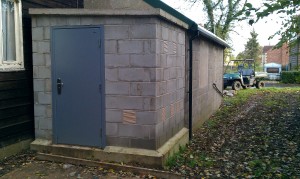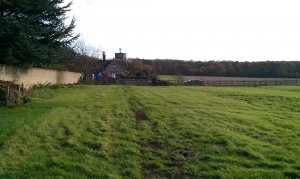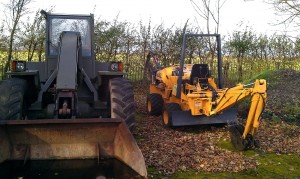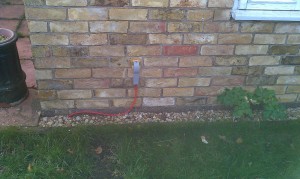The story of Next Generation Broadband Access into the Final Third has to be all about the Digital Village Pump. The phrase has a certain flow to it but this is not about water. This DVP is about bytes.
The concept is that you run a fibre into a village and it terminates into a secure “datacentre” owned and run by the local community. In the picture below the DVP is tucked away nicely at the back of a building in the centre of the village.

The DVP is air cooled with minimal ongoing maintenance and running costs.
How you get the fibre into the village in the first place is going to be different for each community.
There is very often an existing fibre run in an area – serving a school for example. It is not untypical for such runs to have multile strands of fibre, most of which are unused. This just needs identifying. It maybe a wireless feed.
How that community then distributes the connectivity is up to them. It isn’t necessarily feasible to expect people with no experience of data networks to do this themselves but the idea is that they engage a management company to look after the network and provide the service. The ongoing cost of this is covered by the monthly line rental charge paid by participating villagers.
As a rural community, provided the initiative is supported by the main landowners, it is a lot easier to run fibre than in cities. There is no planning permission required to run an utility along the edge of a field. It is necessary to make sure all the relevant wayleaves are obtained which can be time consuming but this is where the cooperation of the landowners comes in.

The village either raises the monies required for the installation itself, uses outside investors or raises funds through funding mechanisms provided by Government, EU etc.
In this way it seems a lot easier to build a network in the countryside than in a town because you are avoiding some of the major obstacles such as the need to dig up roads and fit in with Local Authority planning and works windows.
At the end of the day there is nothing difficult about laying down a network. It is not a black art. It is mostly just planning and digging. The activity can also be made more economical with the support of the local authority which can waive rates due for fibre runs. There is a great deal of sense in doing this because once the internet connectivity is there investment in other infrastructure will come: the conversion of farm units to take other buinesses for example.
The community does need a partner that understands the ins and outs of the business and at Ashby they are fortunate to have NextGenUs working with them. If you are looking at help with getting access to your community I would get in touch.




17 replies on “Next Generation Broadband: The Digital Village Pump”
Really glad you went to look at Ashby for yourself Tref. Citizen reporter indeed. I think it is amazing what they have accomplished in an area so badly served by the incumbent telco for the last decade.
I wonder how long it will be until other villages realise that in the same way they haven’t been able to access 1st generation broadband neither will they get a sniff at ‘Infinity’ either. 😉
Congrats to Lincolnshire. Leading the race to Next Generation Access. Very Lucky to have found NextgenUS.
chris
Can you fill in some of the blanks for us Trefor – is the local fibre LAN point to point with each property having a fibre terminated at the “digital pump” ? Is there a single service provider that all the fibre customers use, or do they pay one party for the connection and another for the internet connectivity and other services ?
1Gbps and point-to-point, WOW!
Does anyone know how much it cost to install?
To answers PhilT:
The 1st mile is point to point fibre (none of this PON nonsense!) connected and lit at 1Gbps symmetric.
NextGenUs UK CIC funded, owns and operates the FttH infrastructure.
At present, NextGenUs provides the connection and internet access as a package due to market failure by other carriers to offer services.
Although there is no Taxpayers Money involved in this first UK FttH deployment, NextGenUs welcomes other service providers wishing to interconnect and take a wholesale service across the local network.
Love this quote: “The 1st mile is point to point fibre (none of this PON nonsense!) connected and lit at 1Gbps symmetric.” from Guy in the comments above/below.
I can not wait to have a FTTH connection. While I have purchased and sold multiple homes over the years, the next one will not be purchased if there is no FTTH Fiber available. This is number 1 on my (and most of my friends) home shopping list, above schools, above crime, before shopping, etc… We want Fiber and we want that fiber to come all they way to our home, not just to the neighborhood and either Coaxial or cellular from there….that is a huge fail.
My next computer will probably have 4 Gigabit Ethernet slots (Fiber Network Interface Cards are still a bit steep for me) so that I can work with very large data pools. Thankfully with Linux I have 100% control and am able to configure the PC in such a way that I can tell my processors how much memory to use and which tasks to focus on.
The only problem I see going forward is bandwidth. Here in the USA, very few companies offer minimum bandwidth guarantees so you have a Cable company promising the world, but throttling back the bandwidth to below DSL level and in many cases Dial up speeds. I pay for 16Mb/2Mb and am constantly throttled back to less than 101Kbps/30Kbps and it is not uncommon to see bandwidth as low as 30Kbps/10Kbps or less. I know it should be a crime, especially considering the 10 year out of date FCC definition of 768Kbps to be considered broadband.
I love articles, news stories and blog posts like this that give the rest of us hope. Hope to have fiber, specifically symmetrical FTTH to our home one day.
I put together a map for the USA, when Google declares their 5 Go Big With a Gig cities, there will be just over 30 communities in the USA offering symetrical FTTH Internet broadband to consumers. And its 2010, not 1996…that is sad when you think about it.
But the future looks bright, here is the Google Map: http://sn.im/1axal4
After reading the latest news :http://www.ispreview.co.uk/story/2010/11/13/isp-bt-claims-it-could-bring-superfast-broadband-to-90-percent-of-uk-by-2017.html
I hope the government give the money to NextgenUS instead, even though that won’t benefit me as i live in a town, i still think NextgenUS should get the money. Villagers still need broadband access as much as city folk….
Having spare fibres or tubes presumably does not affect the cost of installing a new circuit?
How was Ashby funded and any ideas what the costs would be for less rural places with roads and pavements?
It becomes interesting in places where there is 2-3M not and not everyone (yet) is desperate for faster access. Any thoughts?
Access to existing fibre runs means reducing the amount of new fibre that has to be put in. Ashby was privately funded. I am going to publish some costs in a new post a bit later on – keep your eyes open for it
IPv6?
Whats the backhaul like between the DVP and the actual internet? I’m asking because some people think everyone in the village will be sharing a 100Mb connection.
Currently it is on a 1Gig bearer so it is easily upgradeable.
I assume they will upgrade if required then 🙂 might eventually need 10Gig backhaul if everyone signs upto the service although I doubt it, if everyone does though then BT are wrong about not being any demand lol!
But wouldn’t gig backhaul to operate , Like 10 times more than 100Mbp which the cost be passes onto the customer?
But would gig cost more to operate***
Damn phone lol
a gig backhaul would server 10k or more customers – you wouldn’t turn that much bandwidth on if you only had 500 or 1k customers – in that case it would be uneconomical and unnecessary.
Thanks for answering my questions 🙂
How many users and much backhaul is actually switched on currently for Ashby?